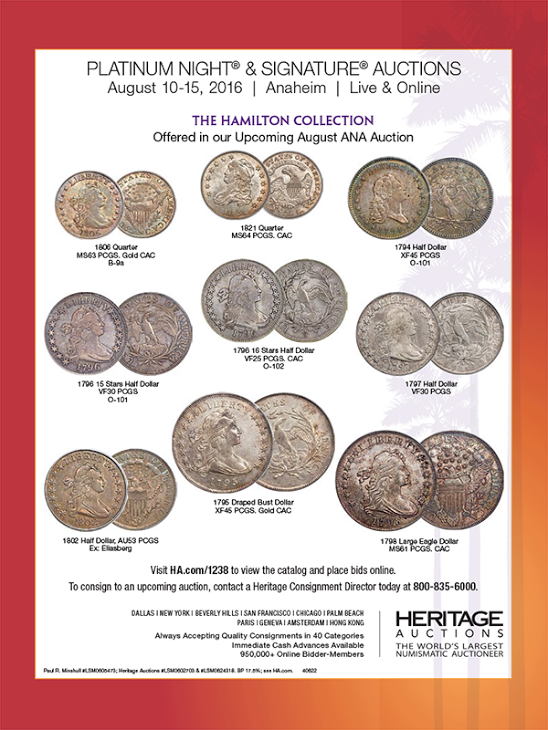
PREV ARTICLE
NEXT ARTICLE
FULL ISSUE
PREV FULL ISSUE
NUMISMATIC VOCABULARY: COPIES AND REPLICAS
Dick Johnson submitted this great collection of terms related to copies and replicas from his Encyclopedia of Coin and Medal
Technology. Thanks! See his ad in this issue to order a copy. -Editor
The article on the replicated button in last week’s E-Sylum has inspired me to discuss the subject of copies and replicas. For coin collectors a coin is either genuine or fake; it's black or white, no shades of gray. This is evident in the MANTIS catalog of all the items in the collections of the American Numismatic Society. All copies are listed as “Fake.” It’s genuine or it's fake. With the Hobby Protection Act of 1973 copies of American coins were now permitted provided COPY is stamped on the coin. There were a few other copies made before this -- like large replicas of coins made into coasters and such – but these attracted little attention from either collectors or the Secret Service. It might surprise collectors there are 13 classes of copy and replicated medals (and some coins). -- 13 different kinds each with a different purpose and each with their own terminology. Here we turn to the list in my Encyclopedia of Coin and Medal Technology for their descriptions. Deluxe Copy – Made with authority for sale to the recipient only in better materials or workmanship than the original, as a decoration prepared in a more precious metal – say it was issued in silver, but the recipient may order it made in gold at his own expense. Custom Copy – Made with authority for sale as a second or subsequent copy (say a decoration to be worn on a second uniform) or to replace a lost original, or other official use; a custom order usually of one made by original maker and dies. Also called replacement medal or sometimes jeweler's copy. Reissue – Copy made with authority after lapse of time without change from original issue and reuse of original dies to strike a new piece or a new production run. Revision – Copy made with authority and with a change of design no matter how minute, requiring retooling the original dies or creating entirely new copy dies. Such change might be a new date, new logo, change of sponsor's name, correct a design error, or similar reason. Replica – Made with authority where a major portion of the previous design is used to make a new coin or medal. Replication is the most common form of copy making. No unauthorized use here, new dies or molds are used to make the new issue. Collectors' Copy – Made with authority for sales primarily to collectors or public; these copies are usually electrotypes (as copies sold by museums of specimens in their collections as the British Museum did in the late 1800s made by Robert Ready and sons). Reproduction – Made without authority and reproduced in a new model or composition. A large gray area of legality. Facsimile – Copy without authority, closely resembling the original and made by any method, as costume jewelry medals. Private Copy – Made without authority for private use; these copies are usually cast in plaster or metal and if sold may be questionable status (study copies cast in plaster for scientific or scholarly study are certainly legal; private metal copies in off metal are a gray area, but copies the same as the original are outright forgeries). Imitation – Copy made without authority and technically not illegal; usually of poor quality, or a souvenir status (to be given away), or play money (as child's play copies, or play coins). Restrike – Copy made without authority from original dies at a later date (and often in deteriorated state, as struck from cracked or rusted dies). Forgery – Copy made without authority and with intent to deceive. Counterfeit – Copy made without authority and with intent to deceive and defraud both collectors and the public. Fake and spurious also denote a counterfeit status. There are two related terms – Contemporary copy – copies made and used while the originals still circulate, say, as ancient coins or early American colonial coins. The second term is Novedel. It means made by the original mint with new copy dies. This was done in Russia and elsewhere. This is an example of the entries in this Encyclopedia. Not all the terms are as long as the 3½ columns on Copies and Replicas, but more than fifty entries are even longer. The book covers the entire field of die=struck numismatic items. To read the earlier E-Sylum article, see:

Wayne Homren, Editor The Numismatic Bibliomania Society is a non-profit organization promoting numismatic literature. See our web site at coinbooks.org. To submit items for publication in The E-Sylum, write to the Editor at this address: whomren@gmail.com To subscribe go to: https://my.binhost.com/lists/listinfo/esylum All Rights Reserved. NBS Home Page Contact the NBS webmaster 
|